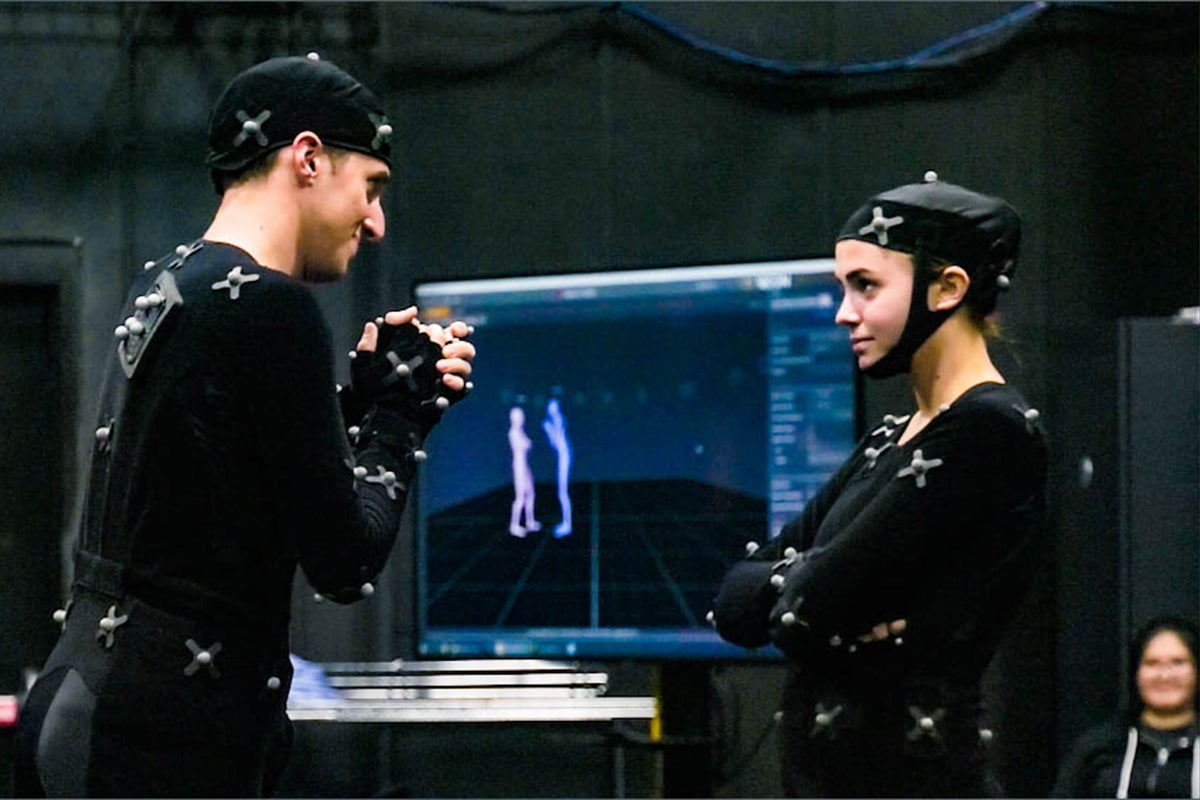Some collaborations come about naturally, while others require out-of-the-box innovation. In many creative fields, developing specialized skills requires collaborating with those outside your discipline. Two collaborations within the UCF College of Arts and Humanities highlight the intersection of performance, technology and production: musical theatre students are suiting up in motion capture suits to work with animation students, and film students are working with stage acting students to create original projects. By working together, theatre, animation and film faculty are providing opportunities for students to create higher-quality educational projects and preparing students to work in professional collaborative environments.
Motion Capture + Acting
Theatre Assistant Professor David Reed, who specializes in stage combat and movement, is “routinely looking for projects that will challenge and inspire” his acting students. He reached out to Cheryl Briggs and Rich Grula, animation faculty members from UCF’s Florida Interactive Entertainment Academy, with his idea: to give his acting students the chance to be involved with motion capture technology, simultaneously providing student animators mocap footage for their projects.
“The hope is for students to walk away from the process with animation footage samples showcasing their ability, as well as new connections that bridge industries,” says Reed.
Grula and Briggs were on board, and the collaboration was born.
Acting professors Be Boyd and John Shafer joined Reed to take their students to the UCF Downtown campus for mocap workshops. Theatre students were given a behind-the-scenes lecture by Briggs before select students developed a performance for mocap. By wearing a specially-designed suit that captures the imprint of the performer, the acting students gain storytelling experience they wouldn’t have had inside the Theatre building.
Briggs, an animation professor, wanted to better prepare her students for the intricacies of the modern animation process. One of her senior character animation classes attended an acting workshop with Boyd where they learned more about the art and intention behind motion. Student Crissy Peters was thrilled to take part.
“This collaboration is really important for us. It helps to know more about acting and human motion so that we can make our animation more realistic and believable,” Peters says.
Another student, Kenna Hornibrook, agreed.
“The best way to understand how the body moves and works is to experience it firsthand. It’s exciting to do things like professionals and see the results.”
To Briggs, collaboration is always a good thing.
“There are a lot of possibilities. The key is finding a mutual benefit for everyone involved,” Briggs says.
Her students now have mocap footage from actors that can be put in a “library of motion” to be used in future projects.
Acting + Film
Boyd saw the opportunity for another collaboration for her Camera Acting and Auditioning classes.
“I had been looking for practical on-camera experiences beyond our classroom for our acting students.”
She contacted Tim Brown, radio/TV program coordinator at the Nicholson School of Communication and Media, and he joined in her enthusiasm.
Students in the acting classes worked with several film and media classes like Narrative Production, Videography and Cinematography lead by faculty members Tim Ritter, Stephanie Rice and Kevin Smith to develop scripts specifically for student actors. This gave acting students the opportunity to connect with budding directors and script writers, becoming the first readers and performers for exciting scripts in development by film and media students.
Acting student Robbie Toussaint felt he gained several skills from working with film students: from the chance to play a myriad of characters, to working with directors of different styles, to learning how to dub over poor audio. To him, the collaboration better prepared both classes for their future careers: “When we get in the real world, we have a head start on everyone else.”
Rice believes her R/TV students have grown immensely from the crossover. “It has been great for the R/TV students to work with professional actors. Their student projects look better than ever because of the theatre involvement.”
Moving Toward the Future
These two collaborations have had profound success, and the hope and potential for similar collaborations in the future is high. The experiences add to the students’ resumes and portfolios, providing an edge in competitive fields and building relationships across disciplines that could open doors in the future.
“This experience was a good test, and I think we should continue to define and shape a collaborative environment between our programs,” says videography faculty Smith. “In the professional world, collaboration is the key to success. Much of what we do is rarely an individual endeavor.”
In upcoming semesters, Boyd hopes to develop a specific class in mocap for acting students so both acting and animation students alike have consistent access to collaborative opportunities for their projects.
“This is a very exciting first step in a relationship that I am sure will continue to grow. Our acting students have gained more practical performance experience in film, media and animation through these collaborations,” says Boyd. “The film and media students will gain a better understanding of coaching actors through the acting process while on set, as well as utilizing their performance skills to enhance their projects. This will lead to more engaging characters in their film and media projects and ultimately better final products for their portfolios. It’s been a wonderful relationship that has benefitted everyone involved in the experience.”




